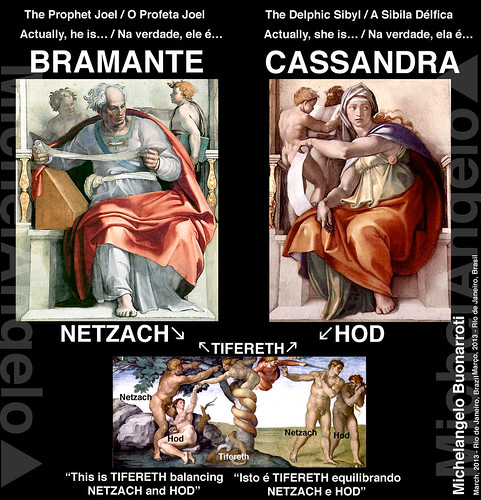Here I found the begining of my secret message of the past to my present reincarnated self. It was not accidental that the first clear remembrance of my italian life highlighted this point. Only myself could understand what's expressed through the Prophet Joel and the Delphic Sibyl because is something related to intimate reasons. These reasons have to do with the moment that I saw that would be impossible to escape from painting of the Sistine Ceiling. So I decided to respond to the circumstances in a way that nobody would never find out what I actually did.
Netzach and Hod are known as the "tactical" sefirot, "meaning that their purpose is not inherent in themselves, but rather as a means for something else." So occurred to me that the right posture to deal with the painting of the Ceiling should follow that idea. Inspired by the sephirot Netzach and Hod, I changed my attitude before the Pope Julius II. I portraied the Pope as the central figure of the sephirah Malkuth, the Prophet Zechariah, but the meaning of this is linked to the Prophet Joel (Netzach) and the Delphic Sibyl (Hod). On the entrance of the Chapel, it's described the situation that forced me to accept the work and what would be my artistic response to it. In one hand, I had a political enemy, Bramante, whose influential position beside the Pope could not be denied. In the other hand, the desire of the Pope to have me working for him could be driven by myself in the direction of his acceptance of my ideas.
My secret agenda was to create a message that could be discovered only by myself centuries in the future. The myths around the origin of Rome and the romans had already passed the proof of time. These myths were constantly repeated by some public figures, stating that the ancient Rome founders believed that they were descendents from the mythical city of Troy. At that point, I already knew what was going to be my tactic against the forced situation of painting the Sistine Ceiling: the Trojan Horse.
But how could my future reincarnated self get aware of my idea? Remember that my intention was to create a message so secret that should be impossible to others of even imagine it. Then came to my mind the mythical figure of Cassandra. If I could remember that the Delphic Sibyl is actually Cassandra, then the rest of the message would depend only on my understanding of my past reasons as Michelangelo to reach the symbolic meaning.
The result is an absolute success.
Cassandra is my message to "Rome", more precisely to the Catholic Church.
The Sistine Ceiling was transformed into my Trojan Horse and one day it will bring "destruction" to the entire "city".
Português:
Aqui começa a minha mensagem secreta do passado para o meu presente reencarnado eu. Não foi por acaso que a primeira lembrança clara da minha vida italiana está ligada a este ponto. Só eu poderia entender o que está expresso através do Profeta Joel e da Sibila de Delfos porque se trata de motivos íntimos, ligados ao momento em que vi que seria impossível escapar da pintura do teto da Capela Sistina. E então decidi responder às circunstâncias de uma forma que ninguém nunca iria descobrir o que realmente fiz.
Netzach e Hod são conhecidos como sefirot "táticas", "o que significa que o seu propósito não é inerente em si, mas sim como um meio para outra coisa." Então me ocorreu que a postura correta para lidar com a pintura do Teto da Sistina deveria seguir essa ideia. Inspirado pelas sephirot Netzach e Hod, mudei de atitude perante o Papa Júlio II. Eu retratei o papa como a figura central da sephirah Malkuth, o profeta Zacarias, cujo significado está ligado ao profeta Joel (Netzach) e da Sibila de Delfos (Hod). Nesta entrada da Capela, está descrita a situação que me obrigou a aceitar o trabalho na Capela e qual seria a minha resposta artística a isto. Por um lado, eu tinha um inimigo político, Bramante, cuja influente posição próximo ao Papa não pode ser negada. Por outro lado, o desejo do Papa em me ter trabalhando para ele poderia ser manipulado até a aceitação dele das minhas ideias.
Minha intenção secreta era criar uma mensagem que só poderia ser descoberta por mim mesmo séculos no futuro. Os mitos em torno da origem de Roma e dos romanos já tinham passado pela prova do tempo. Estes mitos eram constantemente repetidos por figuras públicas, afirmando que os fundadores da Roma antiga acreditavam ser descendentes da mítica cidade de Tróia. Neste ponto, eu idealizei qual seria a minha tática em relação à situação forçada de pintar o teto da Capela Sistina: transformá-la no meu Cavalo de Tróia.
Mas como poderia o meu futuro eu reencarnado reconhecer esta minha idéia? Lembre-se que a intenção era criar uma mensagem tão secreta que seria impossível a outros sequer imaginá-la. Então me veio à mente a figura mítica de Cassandra. Se eu puder lembrar que a Sibila de Delfos é, na realidade, Cassandra, então o resto da mensagem dependeria apenas da compreensão das minhas razões passadas como Michelangelo para chegar ao significado simbólico.
O resultado é um sucesso absoluto.
Cassandra é a minha mensagem para "Roma", mais precisamente para a Igreja Católica.
O teto da Capela Sistina foi transformada em um Cavalo de Tróia que um dia vai provocar a "destruição" da "cidade" inteira.
References/ Referências:
en.wikipedia.org/wiki/Netzach
en.wikipedia.org/wiki/Hod_(Kabbalah)
en.wikipedia.org/wiki/Donato_Bramante
en.wikipedia.org/wiki/Cassandra
en.wikipedia.org/wiki/Malkuth











Nenhum comentário:
Postar um comentário